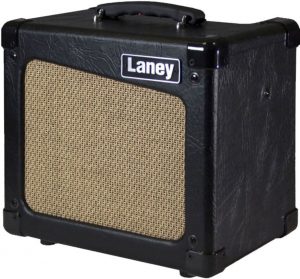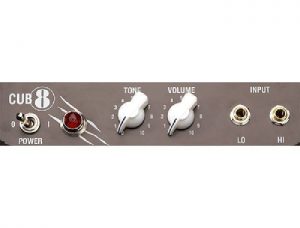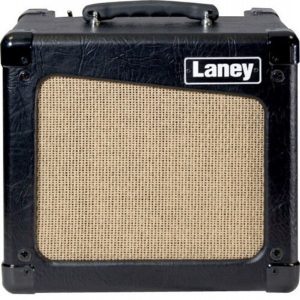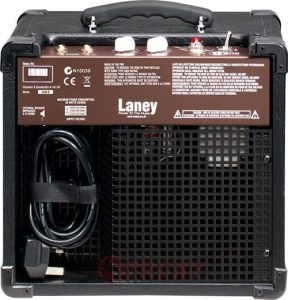One five-watt class A monster, one Laney Cub 8 class A/B charmer: Laney’s new import line makes the miniature valve amp dilemma a whole lot harder. Review by Dave Walsh
Lyndon Laney is something of a reclusive figure in the British guitar industry. Since his humble beginnings in his parents’ garden shed he’s been successfully making amplifiers for over 40 years. But Lyndon is rarely in the spotlight – unlike his contemporary Jim Marshall, for example. Although as a player he once shared a stage with John Bonham and Robert Plant. He soon changed lanes and began a quest to produce great homegrown tone.

Though Lyndon has been happy to stay in the background. His company has survived the considerable trials of British industry over the last four decades and can count Sabbath’s Tony Iommi among its impressive list of users. The once all-British outfit has moved with the times and now has a factory in China. Though some high-end valve amps are still built in the company’s Midlands facility.
As smaller counterparts to its larger Lionheart siblings, the Laney Cub 8 range are portable, low-output recording/bedroom amps. With their distinctive vintage slanted grille design and white chickenhead knobs on chocolate brown control panels. The Cubs are tasty-looking nuggets. And if this review was based on aesthetics alone then I would have been in the pub an hour ago.
Pros and Cons
Table of Contents
The Cub 8 is a brand new amp design for Laney but has its roots fairly and squarely in the very beginning of tube amp production. It features a classic single-ended Class A design and is loaded with a single ECC83 in the preamp section and a single 6V6GT in the output section generating 5W RMS. An eight-inch Celestion Custom speaker lurks inside the open-backed cabinet with the power valve and innards protected by a removable bent steel grille.

The upwards-facing control panel couldn’t be simpler. Apart from the chunky chrome on/off selector switch and Hi/Lo inputs there are just tone and volume controls and a jewel power light to let you know when it’s on. Around the back there’s also an extension cab input which disconnects the onboard speaker and, up on the top. A comfy and substantial plushly padded handle for easy transportation.
Despite the obvious assumption, Laney Cub 10 is not simply a bigger Laney Cub 8. In fact it’s a totally different amplifier. The Cub 10 uses a Class A/B design to produce 10W RMS from an output section loaded with a pair of 6V6GTs, driven from a preamp loaded with two ECC83s. Apart from the size and power differences the control layout is identical to the Cub 8 with the exception of an additional Gain control knob. And the Cub 10 squeezes its sound out through a 10″ Celestion speaker.
Sounds Laney Cub 8
Begin by uncoiling the hardwired power leads from their snug alcove. And nifty Velcro strap at the back of the amps and plugging in to ignite the dome jewel power light. As we waited a couple of minutes for the amps to warm up there was a distinct lack of hiss or pops. And after firing up the Laney Cub 8 with a Strat into the Lo input we gave the roadie the night off.

The Lo input is attenuated down by about 50 per cent compared to the standard Hi and aims to give extra headroom for clean tones. The clean sound was initially a little ‘square’ and boxy. But upping the volume and fiddling with the responsive tone control revealed a bouncy valve tone with a variety of vintage-leaning sounds. There’s plenty of sparkle which hovers just on the right side of fizz.
Volume
Jacking into the Hi input gives an immediate lift and a grittier output. Without a separate gain control the only way to get break-up is to go old-school. Crank the volume control to drive it hard and use the guitar’s volume knob to control the amount of dirt in the signal. There’s very little natural amp compression to hide behind at this volume. So it’s down to the person standing behind the guitar to watch the precision of their playing. And pick attack as even the tiniest playing mistake or sloppiness will be faithfully thrown back at you at volume. For a bit of fun I plugged in an old Boss OD1 pedal to drive the output section harder at more sedate level. And the increased harmonic edge gave the tone a pronounced bottom end. And some lovely lower mids with some added compression and sizzle.

The Laney Cub 8/ 10’s Class A/B output section moves things. In a very broad sense – away from the Cub 8’s ‘Vox-type’ cleaner tone toward a Fender/Marshall influenced voice with a pronounced midrange. Using the same guitar, the jump in breadth was immediate. And having the additional onboard gain control opened a broader range of sounds. The slightly bigger speaker and increased output allow you to stretch out. And touch some neat ’70s rock tones with a very natural and responsive midrange, even when run clean.
Hit the strings harder and the amp breaks up responsively. Dial in more gain and the amp really starts to cook. The pair of 6V6s work hard to give plenty of low-end punch. With lashings of low volume ‘pushed’ valve tones ideally suited to recording. There’s more to play with, and with the amp cranked on the Strat neck pickup. I stumbled across a truly authentic gnarly Texan blues tone which begged for big strings and attitude. This one will get away from you if you’re not careful, but it’s a great ride all the same.
Verdict Laney Cub 8
Laney Cub 8 is a great little amp for many applications with the exception of compressed bedroom level rocking. For that you’ll need a distortion/overdrive pedal. If that isn’t your bag then simply keep it clean, and you’ll find the Class A valve voicing to be warm, supple and great for vintage ’60s twang. The Laney Cub 10. However, has a whole lot more in the locker room for your average player to enjoy. There are plenty of situations when small is king, and the Cub 8 allows you to get that vintage-style tone for peanuts. But the Cub 10 will suit more players across a broader range of styles. Surprisingly different voicings – but at these prices, why not buy one of each?

Leave a Reply
You must be logged in to post a comment.